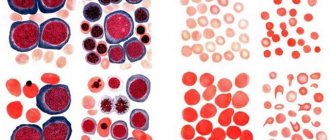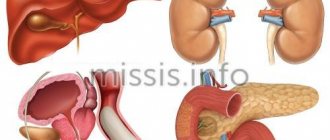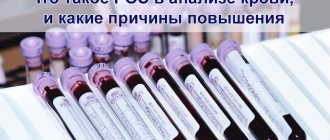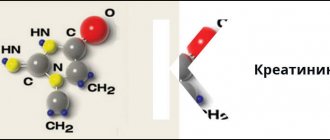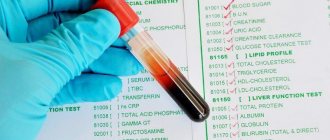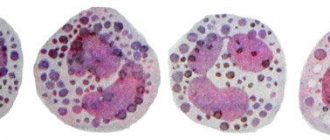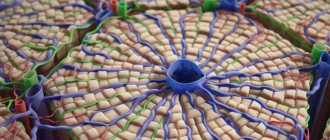The protein component does not have its own color and dissolves in blood serum. Fibrinogen is the basis of blood clots; it is formed in the liver; its renewal is recorded every 3 days. The amount of the element is regularly checked by laboratory diagnostics. A critical minimum or maximum amount of a component can cause serious disruptions in the functioning of the body, provoke long-term bleeding or the formation of blood clots on the inner walls of blood vessels.
What kind of substance
The question of what fibrinogen is arises in people when a blood clotting test is required. And yet, what is fibrinogen? This substance is a protein that is an important component of the thrombus formation process in any bleeding. Its origin occurs in the liver. The process of fibrinogen renewal in the blood plasma takes three to five days. The active state of the protein is called fibrin and appears when blood clots need to form. At other times, this plasma component is in an inactive state.
Functions of fibrinogen include:
- participation in the formation of a blood clot during bleeding;
- impact on the walls of blood vessels during the development of the inflammatory process;
- participation in the regulatory process during the dissolution of blood clots;
- involvement in the process of creating new vessels;
- participation in accelerating the process of restoration of various damage to the skin, mucous tissue, and various organs.
Protein content test
Fibrinogen levels are detected during a coagulogram, in which the blood is examined for various parameters. A fibrinogen test is prescribed:
- as a stage of preparation for surgery, as well as after it;
- in case of disruption of the cardiovascular system;
- for liver disorders;
- for the study of inflammatory processes;
- pregnant women;
- when testing for hemophilia.
The reasons that influence the indicators are identified. In some cases, increased fibrinogen in the blood appears due to stress, excessive physical activity, obesity, high cholesterol and blood sugar, and the use of oral contraceptives. If the protein is elevated, it is urgent to identify the reasons why the deviation occurred. Among the factors that reduce the concentration of fibrinogen in plasma are the following reasons: the use of anabolic steroids, phenobarbital, urokinase, androgens, valproic acid, streptokinase; blood transfusion process. Changes in indicators are possible with colds and flu.
Coagulogram
Factors of the coagulation, anticoagulant (anticoagulant) and fibrinolytic blood systems take part in the hemostasis system. A change in the functional state of one of the systems is accompanied by compensatory changes in the activity of the other. Violation of functional relationships can lead to severe pathological conditions of the body, consisting of either increased bleeding or intravascular thrombus formation. The study of the hemostatic system has the following goals:
- diagnosis of disorders in the hemostasis system;
- clarification of the admissibility of surgical intervention in case of identified disorders in the hemostasis system;
- monitoring treatment with direct and indirect anticoagulants, as well as thrombolytic therapy.
Currently, the usual practice for recognizing hemostasis disorders is heterogeneous and often varies in different clinics from performing one or two uninformative tests (prothrombin index, fibrinogen) to using an overloaded list of methods, some of which duplicate each other.
Many routine tests are outdated, of little value and inaccurate. To date, assessment of the results of prothrombin time using the prothrombin index is incomparable with global methodological approaches. Conditions for taking a coagulogram
Eating food, including juice, tea, coffee, and alcohol, is not allowed for 8 hours (preferably 12) before the test. You can drink plain water. If your doctor has prescribed a test while you are taking medications that affect blood clotting, please note this when taking the test.
List of coagulogram tests:
- Lupus anticoagulant;
- D-dimer;
- Antithrombin II;
- Thrombin time;
- APTT;
- INR (PTV, PTI);
- Fibrinogen;
- Screening for antiphospholipid syndrome.
Lupus Anticoagulant
Lupus Anticoagulant is an inhibitor of the blood anticoagulant system. Being present in the blood, it increases the coagulation activity of the hemostasis system, which adversely affects the process of implantation of the embryo, the course of the entire pregnancy, and the development of the fetus.
D-dimer (fibrin degradation product, D-dimer, Fibrin degradation fragment)
Determination of D-dimer level is a highly specific and sensitive marker of thrombus formation. However, its level also increases in pathological conditions accompanied by increased fibrinolysis: hemorrhagic complications, infections, wound healing, in the presence of rheumatoid factor in the blood, etc. However, the determination of D-dimer has important diagnostic value in the diagnosis of thrombosis. Its normal level allows, with 98% accuracy, to exclude conditions accompanied by increased thrombus formation.
Antithrombin III
AT III is determined by thrombin inhibition. AT III deficiency can be hereditary or acquired. The most common clinical manifestation of hereditary AT III deficiency is the development of deep vein thrombosis and, as a consequence, pulmonary embolism. The likelihood of developing thrombotic complications in patients with AT III deficiency increases with age.
Acquired AT III deficiency may be due to decreased synthesis, increased protein intake, or loss of protein. In all these cases, there is a parallel decrease in the concentration and activity of AT III. AT III is synthesized in the liver, so some liver diseases lead to decreased AT III levels. If, in parallel with the decrease in AT III, there is an increase in the thrombogenic properties of the vascular wall and activation of coagulation, then a further decrease in AT III is observed due to its consumption, which occurs in DIC caused by various pathologies: massive injuries, sepsis, inflammation of wounds, snake bites, complicated pregnancy, cancer, etc.
In addition, a decrease in AT III synthesis is observed during therapy with estrogens and synthetic drugs with estrogenic effects, nephrotic syndrome and gastrointestinal diseases, when the loss of protein exceeds the rate of its synthesis. In these cases, a parallel decrease in AT III and albumin is observed.
Thrombin time (TV)
Gives a general assessment of the final stage of blood coagulation. This is an indicator of the transition of fibrinogen to fibrin, the state of the anticoagulant system. Does not depend on the internal and external activation system, but depends on the concentration of fibrinogen, the presence of abnormal fibrinogen, the activity of antithrombins, the processes of polymerization and stabilization of fibrin.
In the clinic, TV determination is used to monitor heparin therapy (especially high molecular weight heparin) and fibrinolytic therapy; for the diagnosis of activation of fibrinolysis, indirect diagnosis of hypo- and dysfibrinogenemia.
Clinical and diagnostic value
TV shortening:
- hyperfibrinogenemia (more than 6 g/l);
TV extension:
- severe hypofibrinogenemia (less than 1.0 g/l), dysfibrinogenemia;
- heparin therapy with regular heparin (the test detects relatively low concentrations of the anticoagulant - from 0.05 IU/ml of blood);
- the presence of fibrin polymerization inhibitors (PDF, paraproteins, etc.);
- increase in immunoglobulins;
- use of asparaginase, streptokinase, urokinase;
- a decrease in fibrinase activity (factor XIII) does not affect thrombin time.
Activated partial thromboplastin time (APTT)
APTT evaluates the intrinsic pathway of activation of the coagulation process. The test is also called kaolin-kephalin time. It is a simple and comprehensive test, sensitive to deficiencies of all coagulation factors. But it is mainly used to evaluate factors VIII, IX, XI, XII and prekallikrein. Sensitive to excess plasma anticoagulants. Does not depend on platelet count.
This test is one of the main tests for monitoring heparin treatment. In patients receiving heparin therapy, the aPTT lengthens by 1.5–2 times, which indicates the effectiveness of treatment.
Determining the APTT allows you to finally resolve the issue of tolerance to heparin: for this purpose, the APTT is determined 1 hour before the next administration of heparin. If the APTT is prolonged by more than 2.5 times compared to the norm, an increased sensitivity to heparin is noted, its dose is reduced or the interval between injections is increased.
Clinical and diagnostic value
of test extension:
- hypocoagulation and bleeding tendency;
- hemophilia (A, B, C);
- significant deficiency of factors II, V, X, XII, fibrinogen;
- von Willebrand disease;
- heparin therapy with unfractionated heparin (the test detects low concentrations of the anticoagulant - from 0.05 IU/ml of blood);
- treatment with indirect anticoagulants;
- the presence of blood clotting inhibitors (PDF, lupus anticoagulant).
A shortened test indicates hypercoagulability and a tendency to thrombus formation;
and is also observed during normal pregnancy and taking oral contraceptives. Prothrombin (thromboplastin) time (PT)
By means of PT with calculation of the international normalized ratio (INR) and prothrombin index (PI), the external mechanism is assessed in total. Prothrombin time depends on the content of prothrombin itself - factor II, as well as factors V, VII, X and fibrinogen. Used to diagnose thromboembolic and hemorrhagic conditions, to monitor treatment with indirect anticoagulants.
Clinical and diagnostic value
Prolongation of prothrombin time (PI decreases, INR increases) - a tendency to hypocoagulation. Main reasons:
- violation of protein-synthetic function of the liver;
- vitamin K deficiency (usually due to impaired breakdown and absorption of fats in the intestines);
- treatment with indirect anticoagulants;
- deficiency of factors II, V, VII, X;
- heparin therapy with regular heparin (the test responds to relatively high concentrations of the anticoagulant - from 0.5 IU/ml of blood);
- hypo-, dysfibrinogenemia, impaired fibrin polymerization;
- the presence of clotting factor inhibitors (PDF, lupus anticoagulant);
- medications: anabolic steroids, antibiotics, acetylsalicylic acid in large doses, laxatives, methotrexate, nicotinic acid, thiazide diuretics, etc.
Shortening of prothrombin time is rare and has no independent diagnostic value. Together with a shortening of APTT, it indicates a tendency towards hypercoagulation:
- thrombosis;
- increased activity of factor VII (trauma, necrosis);
- pregnancy, childbirth;
- medications: acetylsalicylic acid in small doses, oral contraceptives, corticosteroids, vitamin K, barbiturates, antihistamines, caffeine.
Currently, recording the results of prothrombin time using the prothrombin index does not meet modern requirements.
To unambiguously interpret the results of prothrombin time measurements, regardless of the laboratory, INR is used: this method allows you to mathematically correct the difference given by thromboplastins with different sensitivities. Calculated using thromboplastin standardized to the international sensitivity index. Determination of fibrinogen content
Its concentration is determined by the time of clot formation in diluted platelet-free plasma with the addition of excess highly active thrombin (according to Clauss). Fibrinogen is synthesized in the liver, from where it enters the blood. Changes in fibrinogen concentration are observed in various diseases - primarily in disorders of the hemostasis system and acute inflammation.
An increase in the amount of fibrinogen, even within normal values, is considered a risk factor for cardiovascular diseases.
Clinical and diagnostic value
Increased concentration (tendency to hypercoagulation):
- physiological (pregnancy, menstruation);
- mild forms of hepatitis;
- kidney disease;
- acute phase reactions, myocardial infarction;
- collagenoses;
- radiation sickness;
- malignant tumors (especially lung cancer);
- estrogens, oral contraceptives.
Decreased concentration (a decrease below 0.5–1 g/l causes bleeding):
- congenital afibrinogenemia, hypo- and dysfibrinogenemia;
- severe liver damage;
- condition after bleeding, injury, burn;
- bone marrow lesions (leukemia, tumor metastases);
- activation of fibrinolysis (including drugs);
- phenobarbital, anabolic steroids, unfractionated heparin in high doses.
In DIC syndrome, changes in coagulogram tests depend on the form and stage of the process.
Antiphospholipid syndrome (APL)
This is a group of diseases caused by the presence of antibodies to phospholipids. Antiphospholipid antibodies (APL) are autoantibodies of the IgG and IgM class, capable of binding to the antigenic determinants of phospholipids (cardiolipin, phosphatidylserine, phosphatidylinositol, phosphatidylic acid, phosphatidylcholine) and phospholipid binding proteins. Binding with cardiolipin occurs with the obligatory participation of a cofactor, rg-glycoprotein I.
The reasons for the production of APL have not been established. Presumably, long-term persistence of viruses that are tropic to the vascular endothelium causes: morphological and functional changes in endothelial membrane cells with the development of hypercoagulation syndrome, stimulation of B-lymphocytes, which under certain conditions produce aPL.
APL bind to phospholipids of cell membranes, changing the conformational and metabolic structure of the cell, which leads to disruption of cell function with the development of stasis and thrombosis. Due to the fact that vessels of different sizes and different locations are affected, the range of clinical manifestations of APS is diverse - thrombosis, strokes, obstetric pathology, thrombocytopenia. The incidence of aPL in various pathological conditions is presented below.
Pathological condition/APL detection frequency, %:
- Recurrent venous thrombosis: 28–71
- Recurrent miscarriage: 25–64
- Transverse myelitis: 50
- Thrombocytopenia: 27–33
- Hemolytic anemia: 38
- Arterial thrombosis: 25–31
- Pulmonary hypertension: 20–40
The most significant manifestation of APS is obstetric pathology associated with placental decidual vasculopathy - recurrent miscarriage, antenatal fetal death (usually in the 1st and 2nd trimester), severe forms of gestosis, intrauterine growth retardation.
In the population, aPL is found in 2–4% of the population. The incidence of aPL increases in patients with autoimmune, inflammatory, infectious diseases, malignant tumors, while taking oral contraceptives, psychotropic drugs. APS can be primary (there are no signs of other autoimmune diseases) or secondary (against the background of other autoimmune diseases, most often systemic lupus erythematosus). There is also a seronegative variant of APS, characterized by the absence of aPL and lupus anticoagulant in the presence of clinical manifestations of APS. In this form, only antibodies to glycoprotein I are detected.
The main criterion for the laboratory diagnosis of APS is the presence of aPL (or antibodies to cardiolipin) and lupus anticoagulant in 2 or more studies at least 6 weeks apart.
Indications for prescribing analysis for aPL:
- Obstetric pathology (recurrent miscarriage).
- Recurrent thrombosis of various locations.
- Systemic connective tissue diseases (systemic lupus erythematosus, Sjogren's syndrome).
- Thrombocytopenia.
- False-positive reaction to syphilis using cardiolipin antigen (RW, RPR).
Indications of basic coagulation tests
Test Deficiency and/or inhibition of factors/Effects of anticoagulants
XII, XI, IX, VIII, von Willebrandt, Fletcher, Fitzgerald factors V, X VII II (prothrombin) I (fibrinogen) direct/indirect.
- Thrombin time
- normal/normal/normal/extended/extended/extended/normal. - APTT
- prolonged/prolonged/normal/normal/prolonged/normal/prolonged/prolonged/prolonged. - Prothrombin time (INR)
- normal/extended/extended/extended/normal/extended/extended/extended. - Fibrinogen
- normal/normal/normal/reduced or undetectable/reduced or undetectable/normal/reduced/normal.
Note.
Prothrombin time (INR) results are inversely proportional to prothrombin index results. Outdated methods for studying hemostasis disorders and options for their replacement
Method/Disadvantages/Modern methods.
- Clotting time/Low standardization/APTT.
- Recalcification time/Low standardization/APTT.
- Plasma tolerance to heparin/Low standardization/Plasma thrombin-heparin time, determination of anti-Xa activity.
- Autocoagulation test (ACT)/Low standardization/APTT, antithrombin III activity.
- Beta-naphthol (fibrinogen B), ethanol or protamine sulfate tests / Low-informative, low-quality expression of results, often false positive / Tests for thrombinemia: quantitative determination of SFMC (soluble fibrin-monomer complexes).
Optimal complex of hemostasiological laboratory tests
Test/Hemostasis link/Diagnostic significance.
- Platelet count/Vascular platelet/Main component of platelet hemostasis.
- Von Willebrand factor (VWF)/Vascular platelet/Plasma platelet adhesion cofactor and marker of vascular wall endothelial damage.
- Prothrombin time (PT)/Procoagulant (extrinsic coagulation mechanism)/Screening test to determine the factors (fibrinogen, prothrombin, factors v, VII and X) involved in blood clotting initiated by high concentrations of tissue factor.
- APTT (aPTT)/Procoagulant (intrinsic coagulation mechanism)/Screening test to determine factors (fibrinogen, prothrombin, factors V, VIII, IX, X, XI, XII, prekallikrein and high molecular weight kininogen) involved in blood coagulation upon contact activation. A phospholipid-dependent screening test that provides insight into disorders associated with the effect of the lupus anticoagulant - VA.
- Thrombin time (TT)/Procoagulant (fibrin formation)/Screening test of the last stage of blood coagulation - reaction between thrombin and fibrinogen - anticoagulant activity of antithrombin III.
- Fibrinogen/Procoagulant (substrate)/The main substrate from which fibrin is formed under the action of thrombin.
- D-dimer/Procoagulant and fibrinolytic (activation of coagulation in vivo)/Fibrin degradation product, one of the most specific tests for the diagnosis of DIC syndrome, thrombophilia and thrombosis, a marker of thrombin formation, fibrin formation and activation of secondary fibrinolysis.
- Antithrombin III/Anticoagulant/Basic physiological anticoagulant, for which heparin is a cofactor, inactivates thrombin and active factors IX, X, XI, XII.
- Protein C / Anticoagulant / Physiological anticoagulant, in the activated state, inactivates active factors V, VII, inhibits plasminogen activator (activity manifests itself mainly in the microcirculatory bed).
- Lupus Anticoagulant (LA) Confirmatory Test/Done as part of an extended screening test to confirm the presence of LA.
It is possible that this range of studies is insufficient for patients with severe pathology of the hemostatic system, but in the case of preliminary screening and monitoring of therapy, it seems necessary and sufficient.
Indicators are higher than normal
Fibrinogen levels in the blood of men and women vary within certain limits. The risk group includes patients over 50 years of age. The interpretation of the analysis is carried out by the attending physician:
| Gender/age | Porms |
| Male and female adult population | 2–4 g/l |
| Newborn babies | indicators are within the range of 1.25-3 g/l |
| Pregnancy | the norm for women is maximum for the last trimester 6–7 g/l |
A special category consists of children under one month old and pregnant women. The level of fibrinogen in the blood of women during pregnancy is increased. At the same time, the fibrinogen rate increases throughout the entire period of the interesting situation. Therefore, there is no need to think about how to reduce fibrinogen at this time.
If the study showed fibrinogen above normal, what does this mean and what reasons influenced the result, the doctor decides. This cannot be done on your own or at home. Only a specialist, based on tests and anamnesis, has the right to judge the level of fibrinogen in the blood and its normal level.
For this purpose, appropriate tests are prescribed, which are confirmed by additional studies.
Fibrinogen is increased, what does this mean? If you have increased fibrinogen in your blood, this indicates a risk of increased thrombosis. This is a provoking factor in the development of stroke, heart attack and coronary heart disease. Therefore, when thinking about how to lower fibrinogen levels, it is necessary to look for the reason why the fibrinogen level in the blood increases. Among them are:
- development of inflammatory and autoimmune processes in the body (with pancreatitis, pneumonia, pharyngitis, mononucleosis);
- hormonal imbalance;
- circulatory disorders in brain tissue;
- development of neoplasms;
- disruption of the functioning of peripheral blood vessels in thrombophlebitis, diabetic angiopathy, venous insufficiency, atherosclerosis of the extremities;
- myocardial infarction;
- presence of injuries;
- smoking;
- pregnancy;
- protein metabolism disorder - amyloidosis;
- previous surgery;
- elderly age.
Folk remedies to reduce it
To support efforts to normalize blood composition, in some cases it is advisable to use proven folk methods. Among them, you should pay attention to the following:
- Let's take nattoginase , an enzyme extracted from boiled fermented beans. The essence of taking nattoginase is to reach the limit values of coagulation, at which nattoginase will begin to break down fibrin formed from fibrinogen. Should be taken on an empty stomach, up to 300 mg daily.
- Drinking kombuccia , a natural fermented tea produced using kombucha. It should be taken with caution and should be discontinued a week before menstruation or a few weeks before planned surgery. Potential side effects include: headaches, rashes, diarrhea, nausea, abdominal pain.
- Other recipes based on decoctions and infusions of herbs, willow and birch bark - the number of recipes is huge, however, it is recommended to use them with great caution, after consulting with a specialist.
- Taking raw onion and garlic on an empty stomach.
In addition, it is very important to ensure sufficient magnesium content, which helps oxygenate the blood.
Among the vitamins that you should pay attention to and, with the consent of your doctor, take as additional nutrition, include:
- E;
- B (especially B12);
- C.
Danger during pregnancy
During pregnancy, it is normal if the analysis shows that fibrinogen is elevated in the blood. However, an excessive increase in fibrinogen leads to:
- pathologies of placenta functioning;
- development of vascular thrombosis in the umbilical cord;
- late toxicosis;
- the dangers of early spontaneous abortion;
- stopping the development of pregnancy;
- premature labor.
In order to prevent complications, a woman is regularly prescribed several coagulograms throughout the entire period of bearing a child. In early pregnancy, this allows assessment of initial fibrinogen. An analysis taken immediately before birth helps to promptly identify the risk of thrombosis.
Decrease in indicators
Protein levels can be both increased and decreased, what does this mean? Reduced fibrinogen in the blood is due to the following reasons:
- DIC syndrome associated with impaired intravascular absorption;
- chronic disruption of protein formation processes in the body associated with congenital characteristics or acquired as a result of liver diseases, nutritional disorders;
- pathological processes in the liver;
- lack of B vitamins;
- in newborns - blockage of blood vessels with amniotic fluid;
- myeloid leukemia (cancer of the hematopoietic system);
- polycythemia, that is, an increased content of red blood cells in the blood).
The study of a decrease in fibrinogen levels is due to the fact that it is no less dangerous to exceed them. In this case, it is necessary not only to raise the fibrinogen that is below normal, but also to understand the root cause of the condition that has arisen. At low levels, there is a high risk of internal bleeding.
Solution
Deviation from the norm of fibrinogen does not allow us to draw conclusions about a hidden disease. The indicators make it possible to identify increased or decreased results, but not to detect the original source of the disease. To make a correct diagnosis, the patient must undergo additional laboratory diagnostic examination. Correct identification of existing pathologies will solve the problem.
Doctors warn that ignoring the altered level of fibrinogen and refusing to undergo therapeutic procedures provokes external and internal bleeding (with reduced results) or accelerated formation of blood clots (with an increased amount).
The attending physician makes the final diagnosis and selects a treatment regimen. By seeking professional help in a timely manner, the chances of complications and consequences are significantly reduced.
Proper preparation for analysis
How to get tested? A biochemical blood test, like a general one, requires proper preparation for the study. To do this, before taking blood from a vein: try to avoid stress factors; do not eat food 8 hours before submitting biological material, limit physical activity, and smoke half an hour before visiting the laboratory.
Such actions will help determine the normal indicator and avoid its artificial change. Otherwise, the blood test for fibrinogen will have to be repeated. Most often, fibrinogen is studied by the Claus method, which is based on determining the rate of thrombus formation.
What is the function of fibrinogen and how to determine its level
Fibrinogen is a protein produced by hepatocytes. It stimulates the production of hormones, bile acids, insulin and progesterone. During pregnancy, this blood clotting factor is considered one of the most important indicators of the hemostasiogram.
In this case, the damaged vascular walls are strengthened with the formation of a blood clot, in which the substance acts as the basis of the thrombus. After some time, fibrin is broken down by fibrinolysin, and small substances appear that are gradually absorbed in the body.
Doctors monitor the content of the indicator throughout pregnancy, as it shows the degree of thrombus formation, which is especially important during childbirth. Blood clots reduce blood loss when the baby leaves the womb
At the same time, fibrinolysis during gestation is slowed down.
The fibrinogen content is determined using a hemostasiogram three times during the entire period of pregnancy (in the first, second and third trimesters), unless there are special indications that require a coagulogram more often.
To make the test more informative and help the doctor prevent possible complications, follow the necessary conditions:
- Donate blood in the morning on an empty stomach. You cannot take the test after eating, and you cannot drink juices, tea or coffee an hour before the test. On the eve of the hemostasiogram, it is advisable to have a light dinner, excluding fatty foods 2 days before the test.
- Before a coagulogram, try not to do strenuous work or put stress on the body. Try to get a good night's sleep.
- If you are taking anticoagulants, you should warn your specialist about this.
- 1-2 hours before the test, drink 1 glass of clean water.
To determine the indicator, the pregnant woman comes to the treatment room, where venous blood is drawn. The specialist tightens the forearm with a tourniquet, after which, at the elbow bend, he inserts a needle into a vein, drawing blood into special tubes. After the procedure, the expectant mother squeezes the injection area, and the nurse turns the container with the material over several times to prevent the formation of blood clots in it.
